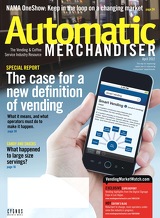Automatic Merchandiser serves the business management, marketing, technology and product information needs of its readers including vending operators, coffee service operators, product brokers, and product and equipment distributors in print.
Page 35 of 47
C O VE R ST O R Y :
S M A R T VE N D I N G
The answer is you would only service that machine when it is com- pletely sold out of everything. When there are no items left in the machine, your revenue collected relative to the cost of that servicing is maximized. However, as any operator knows,
you cannot do that. You will be losing sales if the machine is not serviced
until completely sold out (not to men- tion the customer service nightmare). But it is important to note: you have no idea what you did not sell. All you know is what you collected and what it cost you to service that machine. This subtle, but powerful point is that the opportunity cost is not ever known to the operator.
Intuitively, the operator knows a completely empty machine has resulted in lost sales. But the mag- nitude is not known. Now let's go to a more likely scenario with what an operator may strive for with dynamic scheduling — a system in which machines are scheduled to be serviced not based on a regu- lar schedule but rather based on forecasting when the machine will need to be fi lled (using historical information), or based on real-time telemetry data when a certain level of inventory has sold out.
What is the 'opportunity cost'? When the vending machine is about one third sold out (about 15 out of selections), what is the opportunity cost of that? The operator may know he is col- lecting $250 per servicing and $20,000 per week per route, and that sounds great because the average collection per route has increased signifi cantly as com- pared to a fi xed schedule. However, what is not known is what sales have been lost — the people who did not buy anything. My thesis is that by the time the machine has 15 out of stocks, the cost of lost sales starts exceeding the operational savings. Especially since the fi rst items to sell out represent a disproportionate share of the consumers' demand. While the opportunity cost is
inevitable, the heart of the issue is that the opportunity cost must be balanced with operating cost. This is a diffi cult balancing act because the true opportunity cost is never known. But through experimenting and refi ning the optimal point at which the machine should be serviced, prof- itability can be maximized. It's important to note the oppor- tunity cost is not the same across all machines. A key factor to con-
34 Automatic Merchandiser VendingMarketWatch.com April 2012
